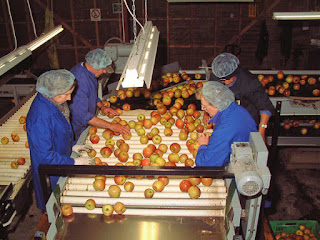Another Bite of New Zealand Apples
Indeed, working as an apple packer for the first time was a humbling experience, but it was a learning process for me too, with the positive experiences outweighing the not-so- pleasant ones.
In this job, I was exposed to an entirely different work situation--my fingers caressed apples instead of computer keyboards, I received wages instead of salary, and worked with other women of different cultures and origins, some of whom were strangers like me in this foreign land. Noticeably missing (or should I say, I “missed”?) in this kind of workplace were the intrigues, professional jealousies, hierarchy, competition and yes, mental stress! These things, as you know come in abundance in the corporate workplace. In their place was an atmosphere of cooperation and interdependence on each other’s diligence.
Anyway, let me describe to you how the “forbidden fruit” is packed and ends in your grocery bags:
A little trivia here, the apple floats in water because 25 percent of its volume is air, and this protects the fruit from knocks and resulting bruises while being washed.
Next, the apples are propelled up an elevator into the packing shed where at least four pre-sorters inspect for any rotten and obviously defective ones. Further scrutiny is done next by more pairs of eyes and hands as the fruits roll on to the next sorting tables, where separation of the good from the bad apples is done. Then, on to the computer-driven color sorter machine that color-bands the apples. As the fruit moves down the grader, each apple is scanned for color intensity. The information is then fed into the computer, which then selects the fruit depending on its size to its assigned packing lane. At this point our job as apple-packers start.
As the apples come rolling down individual lanes, we grab the fruits, arrange them red side up on blue trays, and stack them into specific boxes. The stackers will then pick up the packed box, weighing an average of 18 kilograms, and shift it to the other machine for sealing. Finally, these boxes are stacked onto pallets before being moved into refrigerated shipping containers ready for shipping to different countries like Germany, Europe, the United States and also to some Asian countries like the Philippines. And that’s how your apples are delivered to your favorite fruit stands and supermarkets for your picking.
Meet John and Jamie
But of course, they were our bosses. John Van Vliet and his wife Jamiee own and run JRs Orchard and Packhouse, located in Greytown. Their business has been in operation since 1984 and is the only remaining packhouse in the area (called the South Wairarapa region), where there used to be seven. There are other apple growers in the Wairarapa, so aside from packing their own produce, John and Jamiee also do it for others. “Since we are also orchardists, we treat other apple growers’ fruits like we do our own,” said John, when I interviewed him before the apple packing season ended.
Their management style is one we can call a “hands-on” style, so it’s not unusual to see them mingling with their workers, at times even helping in the sorting, grading and packing of the apples.
During the apple picking and packing season, which starts in early March and ends in mid-June of every year, John and Jamie employ around 165 workers from the South Wairarapa area, which of course, includes our town, Featherston.
On a good working day, they can turn out an average of 2,800 boxes of packed apples, and only around 1,500 boxes a day when fruits and working conditions are not favorable. That can amount to an average of 200,000 boxes of packed apples per season from the Wairarapa area alone.
The biggest buyers of New Zealand apples, according to Mr. Van Vliet are Europe and the United States, but they also export to other small Asian markets. “Only 20 percent of our apples go to the local market,” he added.
Worth mentioning is the fact that JRs Orchard and Packhouse, pay their workers more than the minimum hourly rate of NZ$9.50. Beginners and inexperienced start at NZ$10.00 per hour, while experienced ones may receive an hourly rate of NZ$11.00 or more.
JR acknowledged that there is a shortage of workers for orchardists like him and that he would be interested to employ people from other countries who would be willing to work here. “We can give them the work offer in writing, but they have to secure their work permit. The problem is, the government makes it hard for these people to secure a work permit”, he lamented. “We can not employ them even if they have their tax account number from the Internal Revenue Department without the corresponding work permit.”









